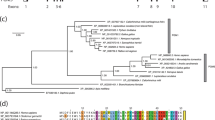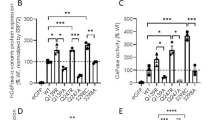Abstract
Recent studies have identified phosphoglucomutase 1 (PGM1) deficiency as an inherited metabolic disorder in humans. PGM1 deficiency is classified as both a muscle glycogenosis (type XIV) and a congenital disorder of glycosylation of types I and II. Affected patients show multiple disease phenotypes, reflecting the central role of the enzyme in glucose homeostasis, where it catalyzes the interconversion of glucose 1-phosphate and glucose 6-phosphate. The influence of PGM1 deficiency on protein glycosylation patterns is also widespread, affecting both biosynthesis and processing of glycans and their precursors. To date, 21 different mutations involved in PGM1 deficiency have been identified, including 13 missense mutations resulting in single amino acid changes. Growing clinical interest in PGM1 deficiency prompts a review of the molecular context of these mutations in the three-dimensional structure of the protein. Here the known crystal structure of PGM from rabbit (97 % sequence identity to human) is used to analyze the mutations associated with disease and find that many map to regions with clear significance to enzyme function. In particular, amino acids in and around the active site cleft are frequently involved, including regions responsible for catalysis, binding of the metal ion required for activity, and interactions with the phosphosugar substrate. Several of the known mutations, however, are distant from the active site and appear to manifest their effects indirectly. An understanding of how the different mutations that cause PGM1 deficiency affect enzyme structure and function is foundational to providing clinical prognosis and the development of effective treatment strategies.




Similar content being viewed by others
References
Arimura T, Inagaki N, Hayashi T et al (2009) Impaired binding of ZASP/Cypher with phosphoglucomutase 1 is associated with dilated cardiomyopathy. Cardiovasc Res 83(1):80–88
Brautaset T, Petersen SB, Valla S (2000) In vitro determined kinetic properties of mutant phosphoglucomutases and their effects on sugar catabolism in Escherichia coli. Metab Eng 2(2):104–114
Dai JB, Liu Y, Ray WJ Jr, Konno M (1992) The crystal structure of muscle phosphoglucomutase refined at 2.7- angstrom resolution. J Biol Chem 267(9):6322–6337
DeLano WL (2002) The PyMOL Molecular Graphics System. eds. Book The PyMOL Molecular Graphics System San Carlos, CA: DeLano Scientific
Dundas J, Ouyang Z, Tseng J, Binkowski A, Turpaz Y, Liang J (2006) CASTp: computed atlas of surface topography of proteins with structural and topographical mapping of functionally annotated residues. Nucleic acids research 34(Web Server issue):W116–W118
Freeze HH (2013) Understanding human glycosylation disorders: biochemistry leads the charge. J Biol Chem 288(10):6936–6945
Freeze HH, Chong JX, Bamshad MJ, Ng BG (2014) Solving glycosylation disorders: fundamental approaches reveal complicated pathways. Am J Hum Genet 94(2):161–175
Gouet P, Robert X, Courcelle E (2003) ESPript/ENDscript: extracting and rendering sequence and 3D information from atomic structures of proteins. Nucl Acids Res 31(13):3320–3323
Gururaj A, Barnes CJ, Vadlamudi RK, Kumar R (2004) Regulation of phosphoglucomutase 1 phosphorylation and activity by a signaling kinase. Oncogene 23(49):8118–8127
Lee Y, Mehra-Chaudhary R, Furdui C, Beamer LJ (2013) Identification of an essential active-site residue in the alpha-d-phosphohexomutase enzyme superfamily. FEBS J 280:2622–2632
Lee Y, Villar MT, Artigues A, Beamer LJ (2014) Promotion of enzyme flexibility by dephosphorylation and coupling to the catalytic mechanism of a phosphohexomutase. J Biol Chem 289(8):4674–4682
Liu Y, Ray W, Baranidharan S (1997) Structure of rabbit muscle phosphoglucomutase refined at 2.4 Å resolution. Acta Crystallogr D 53:392–405
Luebbering EK, Mick J, Singh RK, Tanner JJ, Mehra-Chaudhary R, Beamer LJ (2012) Conservation of functionally important global motions in an enzyme superfamily across varying quaternary structures. J Mol Biol 423(5):831–846
Maliekal P, Sokolova T, Vertommen D, Veiga-da-Cunha M, Van Schaftingen E (2007) Molecular identification of mammalian phosphopentomutase and glucose-1,6-bisphosphate synthase, two members of the alpha-D-phosphohexomutase family. J Biol Chem 282(44):31844–31851
March RE, Putt W, Hollyoake M et al (1993) The classical human phosphoglucomutase (PGM1) isozyme polymorphism is generated by intragenic recombination. Proc NatlAcad Sci USA 90(22):10730–10733
McAlpine PJ, Hopkinson DA, Harris H (1970) The relative activities attributable to the three phosphoglucomutase loci (PGM1, PGM2, PGM3) in human tissues. Ann Hum Gen 34(2):169–175
Muller S, Diederichs K, Breed J et al (2002) Crystal structure analysis of the exocytosis-sensitive phosphoprotein, pp 63/parafusin (phosphoglucomutase), from Paramecium reveals significant conformational variability. J Mol Biol 315(2):141–153
Muntau AC, Leandro J, Staudigl M, Mayer F, Gersting SW (2014) Innovative strategies to treat protein misfolding in inborn errors of metabolism: pharmacological chaperones and proteostasis regulators. J Inherit Metab Dis 37(4):505–523
Nishitani Y, Maruyama D, Nonaka T et al (2006) Crystal structures of N-acetylglucosamine-phosphate mutase, a member of the alpha-D-phosphohexomutase superfamily, and its substrate and product complexes. J Biol Chem 281(28):19740–19747
Ondruskova N, Honzik T, Vondrackova A, Tesarova M, Zeman J, Hansikova H (2014) Glycogen storage disease-like phenotype with central nervous system involvement in a PGM1-CDG patient. Neuro Endocrinol Lett 35(2):137–141
Perez B, Medrano C, Ecay MJ et al (2013) A novel congenital disorder of glycosylation type without central nervous system involvement caused by mutations in the phosphoglucomutase 1 gene. J Inherit Metab Dis 36(3):535–542
Quick CB, Fisher RA, Harris H (1974) A kinetic study of the isozymes determined by the three human phosphoglucomutase loci PGM1, PGM2, and PGM3. Eur J Biochem 42(2):511–517
Ray WJ Jr, Burgner JW 2nd, Post CB (1990) Characterization of vanadate-based transition-state-analogue complexes of phosphoglucomutase by spectral and NMR techniques. Biochemistry 29(11):2770–2778
Regni C, Naught LE, Tipton PA, Beamer LJ (2004) Structural basis of diverse substrate recognition by the enzyme PMM/PGM from P. aeruginosa. Structure 12(1):55–63
Regni C, Schramm AM, Beamer LJ (2006) The reaction of phosphohexomutase from Pseudomonas aeruginosa: structural insights into a simple processive enzyme. J Biol Chem 281(22):15564–15571
Schramm AM, Mehra-Chaudhary R, Furdui CM, Beamer LJ (2008) Backbone flexibility, conformational change, and catalysis in a phosphohexomutase from Pseudomonas aeruginosa. Biochemistry 47(35):9154–9162
Schramm AM, Karr D, Mehra-Chaudhary R, Van Doren SR, Furdui CM, Beamer LJ (2010) Breaking the covalent connection: chain connectivity and the catalytic reaction of PMM/PGM. Protein Sci 19(6):1235–1242
Shackelford GS, Regni CA, Beamer LJ (2004) Evolutionary trace analysis of the alpha-D-phosphohexomutase superfamily. Protein Sci 13(8):2130–2138
Sievers F, Wilm A, Dineen D et al (2011) Fast, scalable generation of high-quality protein multiple sequence alignments using Clustal Omega. Mol Syst Biol 7:539
Stojkovic T, Vissing J, Petit F et al (2009) Muscle glycogenosis due to phosphoglucomutase 1 deficiency. N Engl J Med 361(4):425–427
Takahashi N, Neel JV (1993) Intragenic recombination at the human phosphoglucomutase 1 locus: predictions fulfilled. Proc Natl Acad Sci U S A 90(22):10725–10729
Tegtmeyer LC, Rust S, van Scherpenzeel M et al (2014) Multiple phenotypes in phosphoglucomutase 1 deficiency. N Engl J Med 370(6):533–542
Timal S, Hoischen A, Lehle L et al (2012) Gene identification in the congenital disorders of glycosylation type I by whole-exome sequencing. Hum Mol Genet 21(19):4151–4161
Wei Y, Marcink TC, Xu J, et al (2013) Chemical shift assignments of domain 4 from the phosphohexomutase from Pseudomonas aeruginosa suggest that freeing perturbs its coevolved domain interface. Biomol NMR Assign July 13
Whitehouse DB, Tomkins J, Lovegrove JU, Hopkinson DA, McMillan WO (1998) A phylogenetic approach to the identification of phosphoglucomutase genes. Mol Biol Evol 15(4):456–462
Acknowledgments
I thank Charlotte Phillips and several helpful reviewers for comments on the manuscript. This work was supported by a grant from the National Science Foundation (MCB-0918389).
Compliance with Ethics Guidelines
ᅟ
Conflict of interest
None.
Human and Animal Rights and Informed Consent
This article does not contain any studies with human or animal subjects performed by any of the authors.
Author information
Authors and Affiliations
Corresponding author
Additional information
Communicated by: Eva Morava
Electronic supplementary material
Below is the link to the electronic supplementary material.
Table S1
Summary of PGM1 deficiency mutants and their clinical phenotypes. (GIF 856 kb)
Fig. S1
Superposition of the 3D structure of rabbit PGM (light orange; PDB ID:3pmg), parafusin from P. tetraurelia (pink; PDB ID:1kfi), S. typhimurium PGM (light blue; PDB ID:3na5), and P. aeruginosa PMM/PGM (light green; PDB ID:1 k35). Note the high structural similarity, especially around the central active site cleft. Domain 4 (on right) shows more variability due to its mobility relative to the rest of the enzyme. (GIF 3503 kb)
Fig. S2
Amino acid sequence alignments of the proteins used in our structural analyses, all members of the α-D-phosphexomutase superfamily: rabbit PGM (UniProtKB P00949), parafusin from P. tetraurelia (UniProtKB P47244), S. typhimurium PGM (UniProtKB Q8ZQW9), and P. aeruginosa PMM/PGM (UniProtKB P26276). Residues involved in key regions (i-iv) of the active site (see text) are highlighted by orange shading. Overall amino acid sequence identities between rabbit PGM and the other proteins are: parafusin – 54 %; S. typhimurium PGM – 25 %; and P. aeruginosa PMM/PGM – 22 %. Residues involved in missense mutations associated with human PGM1 deficiency are indicated below brown triangles; residues that are known functional polymorphic variants of human PGM1 are indicated below green triangles. See also Fig. 2. (GIF 2094 kb)
Rights and permissions
About this article
Cite this article
Beamer, L.J. Mutations in hereditary phosphoglucomutase 1 deficiency map to key regions of enzyme structure and function. J Inherit Metab Dis 38, 243–256 (2015). https://doi.org/10.1007/s10545-014-9757-9
Received:
Revised:
Accepted:
Published:
Issue Date:
DOI: https://doi.org/10.1007/s10545-014-9757-9




